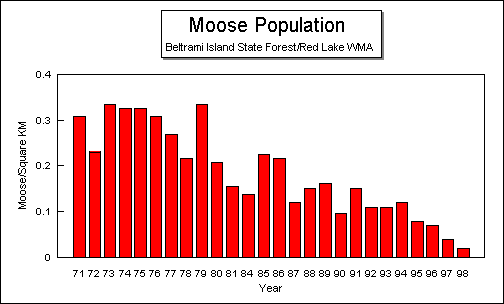MOOSE
Moose is an Algonquin word meaning twig-eater, and indeed the big mammal eats a massive amount of twigs and other browse.
A Minnesota or Canada bull moose weights around 800-900 pounds, which is small compared to an Alaskan bull moose, which can weigh up to 1,800 pounds. Its coat is usually dark brown to almost black. Adults have a shoulder hump and a flap of skin--called a bell or dewlap--hanging below the throat.
Bulls carry antlers which become palmated (flat and extended) after the third year.
Moose have long legs and spreading hooves that help them in marshes and deep snow. They have poor eyesight but great senses of smell and hearing. They are also excellent swimmers and have been known to cross lakes more than a mile wide.
Today, moose inhabit much of Northwest Minnesota. Moose hunting and viewing have become important economic supplements to communities throughout this part of the state. This was not always the case. In 1922, moose hunting was banned throughout Minnesota because of the dwindling numbers of moose. Only a few remained scattered along the Canadian borderMoose numbers increased during the 1930`s in the Beltrami Island State Forest Area, also known as the "Big Bog." By 1941 this area was considered one of the best moose ranges in the state. Moose gradually spread to most of northwest Minnesota and part of northeast North Dakota by the mid 1940's.
During the last 25 years, moose numbers declined throughout the "Big Bog". Further west, in areas with more agriculture, moose numbers had remained higher during the same period .

More recently, moose numbers have dramatically declined in the Agassiz National Wildlife Refuge and surrounding State Wildlife Management Areas. All of these areas have habitat similar to the "Big Bog."
Why have moose declined on these ranges?
Has habitat deterioration forced moose to move to nontraditional habitats?
Are parasites and disease causing the decline?
What roles do hunter harvest and predation by black bears and gray wolves play in the decline?To answer these questions, state and federal wildlife managers began to take a closer look at the dynamics of moose populations in northwest Minnesota in 1995.
